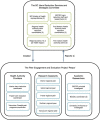Participant, peer and PEEP: considerations and strategies for involving people who have used illicit substances as assistants and advisors in research
- PMID: 29976169
- PMCID: PMC6034321
- DOI: 10.1186/s12889-018-5765-2
Participant, peer and PEEP: considerations and strategies for involving people who have used illicit substances as assistants and advisors in research
Abstract
Background: The Peer Engagement and Evaluation Project (PEEP) aimed to engage, inspire, and learn from peer leaders who represented voices of people who use or have used illicit substances, through active membership on the 'Peeps' research team. Given the lack of critical reflection in the literature about the process of engaging people who have used illicit substances in participatory and community-based research processes, we provide a detailed description of how one project, PEEP, engaged peers in a province-wide research project.
Methods: By applying the Peer Engagement Process Evaluation Framework, we critically analyze the intentions, strategies employed, and outcomes of the process utilized in the PEEP project and discuss the implications for capacity building and empowerment among the peer researchers. This process included: the formation of the PEEP team; capacity building; peer-facilitated data collection; collaborative data analysis; and, strengths-based approach to outputs.
Results: Several lessons were learned from applying the Peer Engagement Process Evaluation Framework to the PEEP process. These lessons fall into themes of: recruiting and hiring; fair compensation; role and project expectations; communication; connection and collaboration; mentorship; and peer-facilitated research.
Conclusion: This project offers a unique approach to engaging people who use illicit substances and demonstrates how participation is an important endeavor that improves the relevance, capacity, and quality of research. Lessons learned in this project can be applied to future community-based research with people who use illicit substances or other marginalized groups and/or participatory settings.
Keywords: Community-based participatory research; Drug use; Participation; Peer engagement; Qualitative research; Research methods.
Conflict of interest statement
Ethics approval and consent to participate
Ethical approval for the Peer Engagement and Evaluation Project was obtained from the University of British Columbia and University of Victoria ethics boards. All PEEP team members were co-investigators on the ethics applications. Research participants gave informed verbal consent after being read the consent form and had a hard copy to keep of the study details and who to contact with concerns. Written consent was not appropriate given that participants were from a vulnerable population and would be discussing substance use, a criminalized and stigmatized behavior in Canada.
Consent for publication
Not applicable.
Competing interests
The authors declare that they have no competing interests.
Publisher’s Note
Springer Nature remains neutral with regard to jurisdictional claims in published maps and institutional affiliations.
Figures
Similar articles
-
Meaningful engagement of people living with HIV who use drugs: methodology for the design of a Peer Research Associate (PRA) hiring model.Harm Reduct J. 2016 Oct 7;13(1):26. doi: 10.1186/s12954-016-0116-z. Harm Reduct J. 2016. PMID: 27717364 Free PMC article.
-
Hiring, training, and supporting Peer Research Associates: Operationalizing community-based research principles within epidemiological studies by, with, and for women living with HIV.Harm Reduct J. 2019 Jul 18;16(1):47. doi: 10.1186/s12954-019-0309-3. Harm Reduct J. 2019. PMID: 31319894 Free PMC article.
-
Community-based participatory research in a heavily researched inner city neighbourhood: Perspectives of people who use drugs on their experiences as peer researchers.Soc Sci Med. 2017 Mar;176:85-92. doi: 10.1016/j.socscimed.2017.01.027. Epub 2017 Jan 21. Soc Sci Med. 2017. PMID: 28135693 Free PMC article.
-
The ethics of community-based research with people who use drugs: results of a scoping review.BMC Med Ethics. 2016 Apr 29;17(1):25. doi: 10.1186/s12910-016-0108-2. BMC Med Ethics. 2016. PMID: 27129927 Free PMC article.
-
'Now we call it research': participatory health research involving marginalized women who use drugs.Nurs Inq. 2010 Dec;17(4):336-45. doi: 10.1111/j.1440-1800.2010.00507.x. Nurs Inq. 2010. PMID: 21059151 Review.
Cited by
-
Using community-based participatory research methods to build the foundation for an equitable integrated health data system within a Canadian urban context.Int J Equity Health. 2024 Jul 1;23(1):131. doi: 10.1186/s12939-024-02179-3. Int J Equity Health. 2024. PMID: 38951827 Free PMC article.
-
The effect of a methadone reformulation on opioid agonist treatment outcomes: A population-based study in British Columbia, Canada, 2013-14.J Subst Abuse Treat. 2022 Jul;138:108714. doi: 10.1016/j.jsat.2021.108714. Epub 2021 Dec 28. J Subst Abuse Treat. 2022. PMID: 35101357 Free PMC article.
-
Doing community-based research during dual public health emergencies (COVID and overdose).Harm Reduct J. 2023 Sep 15;20(1):135. doi: 10.1186/s12954-023-00852-4. Harm Reduct J. 2023. PMID: 37715202 Free PMC article.
-
A scoping review of methods to measure and evaluate citizen engagement in health research.Res Involv Engagem. 2022 Dec 10;8(1):72. doi: 10.1186/s40900-022-00405-2. Res Involv Engagem. 2022. PMID: 36496455 Free PMC article.
-
Research evidence and implementation gaps in the engagement of people with lived experience in mental health and substance use research: a scoping review.Res Involv Engagem. 2023 May 11;9(1):32. doi: 10.1186/s40900-023-00442-5. Res Involv Engagem. 2023. PMID: 37170357 Free PMC article.
References
-
- Barratt MJ, Lenton S. Beyond recruitment? Participatory online research with people who use drugs. Int J Internet Res Ethics. 2010;3:69–86.
MeSH terms
Substances
Grants and funding
LinkOut - more resources
Full Text Sources
Other Literature Sources
Medical



